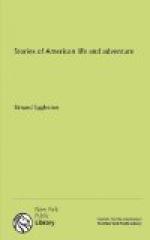“We must have swords,” said Keketaw.
“We can cut our meat with this,” said Henry, pointing to a knife made of cane, such as the Indians called a pamesack.
“But the Monacans may come,” said Keketaw. “If we should see one sticking up his head, I should want a sword to fight him with; and if we should kill him, we could cut off his scalp with it;” and Keketaw’s eyes glistened a little at the thought of fetching home a Monacan’s scalp.
The Monacans were fierce Indians of a tribe living in the country west of the Powhatan Indians. They were deadly enemies of Keketaw’s tribe.
The two boys, by much slow work with stones and shells and beaver-tooth chisels, managed to scrape a wooden sword into shape. This, Henry was to wear at his back. Keketaw, for his part, found a piece of deer’s horn. He stuck it into a stick so that it made something like a small pickax. With this he said he could quickly break the head of a Monacan. It would also serve as a sort of hatchet.
The land round the village in which Keketaw lived had been cleared of trees. This had been done by burning the trees in order to make room for fields. In these fields the Indians planted corn, beans, pumpkins, and tobacco, and a plant something like a sunflower, which is called an artichoke. Of the root of this artichoke they made a kind of bread.
For many miles there were no good canoe trees near the water. They had all been picked out and used. Henry and Keketaw traveled twenty miles into a deep woods, and chose a tree that would make a good canoe, and that stood near a stream which ran into the James River.
The first thing they did was to break down young trees and boughs, and build themselves a brush tent. They made a bed out of dry leaves. The first night they had nothing to eat, for they had no time to shoot any game. The next morning they were too hungry to sleep late, and they knew that squirrels are early risers. Soon after daylight the Indian boy killed a squirrel with an arrow. Having no fire, they ate it without cooking; for, when one is a savage, one must not be too nice.
How should they get a fire? They first took a piece of dry wood, which they scraped flat with stones. Then, with a blow of his tomahawk of deer’s horn, Keketaw made a round hole in the wood. One end of a dry stick was placed in this hole. The other end was supported in the hollow of a shell which Keketaw held in his hand.
The string to Henry’s bow was made of one of the cords or sinews of a deer’s leg. He wound this once round the stick. With his left hand, Keketaw then put some dry moss about the stick where it entered the hole in the dry wood.
When all was ready, Henry drew his bow to and fro like a saw. Keketaw pressed the shell down on the upper part of the stick. The bow-string holding the stick made it whirl in the hole beneath. At first this seemed to produce no effect. After a while the rapid rubbing of the piece of wood in the hole made heat. Presently a very thin thread of smoke began to come up through the little heap of moss about the stick. Henry was now pretty well out of breath, but he sawed the bow faster than ever. At last the moss began to smolder and to show fire.




